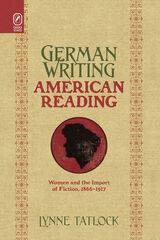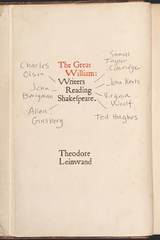145 books about Appreciation and 4
start with G
145 books about Appreciation and 4
145 books about Appreciation
4 start with G start with G
4 start with G start with G

German Writing, American Reading
Women and the Import of Fiction, 1866–1917
Lynne Tatlock
The Ohio State University Press, 2012
In postbellum America, publishers vigorously reprinted books that were foreign in origin, and Americans thus read internationally even at a moment of national consolidation. A subset of Americans’ international reading—nearly 100 original texts, approximately 180 American translations, more than 1,000 editions and reprint editions, and hundreds of thousands of books strong—comprised popular fiction written by German women and translated by American women. German Writing, American Reading: Women and the Import of Fiction, 1866–1917 by Lynne Tatlock examines the genesis and circulation in America of this hybrid product over four decades and beyond. These entertaining novels came to the consumer altered by processes of creative adaptation and acculturation that occurred in the United States as a result of translation, marketing, publication, and widespread reading over forty years. These processes in turn de-centered and disrupted the national while still transferring certain elements of German national culture. Most of all, this mass translation of German fiction by American women trafficked in happy endings that promised American readers that their fondest wishes for adventure, drama, and bliss within domesticity and their hope for the real power of love, virtue, and sentiment could be pleasurably realized in an imagined and quaintly old-fashioned Germany—even if only in the time it took to read a novel.
[more]

Ghosts and the Overplus
Reading Poetry in the Twenty-First Century
Christina Pugh
University of Michigan Press, 2024
Ghosts and the Overplus is a celebration of lyric poetry in the twenty-first century and how lyric poetry incorporates the voices of our age as well as the poetic “ghosts” from the past. Acclaimed poet and award-winning teacher Christina Pugh is fascinated by how poems continually look backward into literary history. Her essays find new resonance in poets ranging from Emily Dickinson to Gwendolyn Brooks to the poetry of the present. Some of these essays also consider the way that poetry interacts with the visual arts, dance, and the decision to live life as a nonconformist. This wide-ranging collection showcases the critical discussions around poetry that took place in America over the first two decades of our current millennium. Essay topics include poetic forms continually in migration, such as the sonnet; poetic borrowings across visual art and dance; and the idiosyncrasies of poets who lived their lives against the grain of literary celebrity and trend. What unites all of these essays is a drive to dig more deeply into the poetic word and act: to go beyond surface reading in order to reside longer with poems. In essays both discursive and personal, Pugh shows that poetry asks us to think differently—in a way that gathers feeling into the realm of thought, thereby opening the mysteries that reside in us and in the world around us.
[more]

Gogol's Afterlife
The Evolution of a Classic in Imperial and Soviet Russia
Caryl Emerson
Northwestern University Press, 2002
Gogol's claim to the title of national literary classic is incontestable. An exemplar of popular audiences no less than for the intelligentsia, Gogol was pressed into service under the tsarist and Soviet regimes for causes both aesthetic and political, official and unofficial. In Gogol's Afterlife, Stephen Moeller-Sally explores how he achieved this peculiar brand of cultural authority and later maintained it, despite dramatic shifts in the organization of Russian literature and society.
Part I charts the historical and cultural currents that shaped Gogol's reputation, devoting particular attention to the models of authorship Gogol himself devised in response to his changing audience and developing authorial mission. Part II takes a panoramic view of the social milieu in which Gogol's status evolved. Finally, Part III examines the place of the classics in Soviet culture, with a focus on Gogol's role in the cultural revolution and his peculiar relationship with state power under Stalinism.
Part I charts the historical and cultural currents that shaped Gogol's reputation, devoting particular attention to the models of authorship Gogol himself devised in response to his changing audience and developing authorial mission. Part II takes a panoramic view of the social milieu in which Gogol's status evolved. Finally, Part III examines the place of the classics in Soviet culture, with a focus on Gogol's role in the cultural revolution and his peculiar relationship with state power under Stalinism.
[more]

The Great William
Writers Reading Shakespeare
Theodore Leinwand
University of Chicago Press, 2016
The Great William is the first book to explore how seven renowned writers—Samuel Taylor Coleridge, John Keats, Virginia Woolf, Charles Olson, John Berryman, Allen Ginsberg, and Ted Hughes—wrestled with Shakespeare in the very moments when they were reading his work. What emerges is a constellation of remarkable intellectual and emotional encounters.
Theodore Leinwand builds impressively detailed accounts of these writers’ experiences through their marginalia, lectures, letters, journals, and reading notes. We learn why Woolf associated reading Shakespeare with her brother Thoby, and what Ginsberg meant when referring to the mouth feel of Shakespeare’s verse. From Hughes’s attempts to find a “skeleton key” to all of Shakespeare’s plays to Berryman’s tormented efforts to edit King Lear, Leinwand reveals the palpable energy and conviction with which these seven writers engaged with Shakespeare, their moments of utter self-confidence and profound vexation. In uncovering these intense public and private reactions, The Great William connects major writers’ hitherto unremarked scenes of reading Shakespeare with our own.
Theodore Leinwand builds impressively detailed accounts of these writers’ experiences through their marginalia, lectures, letters, journals, and reading notes. We learn why Woolf associated reading Shakespeare with her brother Thoby, and what Ginsberg meant when referring to the mouth feel of Shakespeare’s verse. From Hughes’s attempts to find a “skeleton key” to all of Shakespeare’s plays to Berryman’s tormented efforts to edit King Lear, Leinwand reveals the palpable energy and conviction with which these seven writers engaged with Shakespeare, their moments of utter self-confidence and profound vexation. In uncovering these intense public and private reactions, The Great William connects major writers’ hitherto unremarked scenes of reading Shakespeare with our own.
[more]
READERS
Browse our collection.
PUBLISHERS
See BiblioVault's publisher services.
STUDENT SERVICES
Files for college accessibility offices.
UChicago Accessibility Resources
home | accessibility | search | about | contact us
BiblioVault ® 2001 - 2024
The University of Chicago Press









